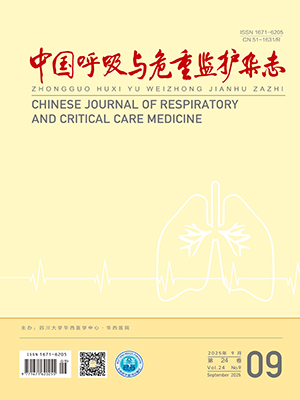| 1. |
American Thoracic Society, European Respiratory Society. American Thoracic Society/European Respiratory Society International Multidisciplinary Consensus Classification of the Idiopathic Interstitial Pneumonias. This Joint Statement of the American Thoracic Society (ATS), and the European Respiratory Society (ERS) was adopted by the ATS board of directors, June 2001 and by the ERS Executive Committee, June 2001. AmJ Respir Crit Care Med, 2002, 165(2): 277-304.
|
| 2. |
Epler GR. Bronchiolitis obliterans organizing pneumonia. Arch Intern Med, 2001, 161(2): 158-164.
|
| 3. |
Epler GR, Colby TV, Mc Loud TC, et al. Bronchiolitis obliterans organizing pneumonia. N Engl J Med, 1985, 312(3): 152-158.
|
| 4. |
Cordier JF. Cryptogenic organizing pneumonia. Clin Chest Med, 2004, 25(4): 727-738.
|
| 5. |
蔡后荣, 李惠萍. 实用间质性肺疾病. 北京: 人民卫生出版社, 2010, 98-111.
|
| 6. |
蔡后荣, 侯杰. 隐源性机化性肺炎的临床、病理和影像学诊断. 中国医学影像技术, 2005, 21(7): 1133-1136.
|
| 7. |
施举红, 许文兵, 刘鸿瑞, 等. 隐源性机化性肺炎 18 例的临床病理特征. 中华肺结核和呼吸杂志, 2006, 29(3): 167-170.
|
| 8. |
Schlesinger C, Koss MN. The organizing pneumonia: an update and review. Curr Opin Pulm Med, 2005, 11(5): 422-430.
|
| 9. |
Bradley B, Branley HM, Egan JJ, et al. Interstitial lung disease guideline: the British Thoracic Society in collaboration with the Thoracic Society of Australia and New Zealand and the Irish Thoracic Society. Thorax, 2008, 63(Suppl 5): v1-v58.
|
| 10. |
Pathak V, Kuhn JM, Durham C, et al. Macrolide use leads to clinical and radiological improvement in patients with cryptogenic organizing pneumonia. Ann Am Thorac Soc, 2014, 11(1): 87-91.
|
| 11. |
Shitenberg D, Fruchter O, Fridel L, Kramer MR. Successful rituximab therapy in steroid-resistant, cryptogenic organizing pneumonia: a case series. Respiration, 2015, 90(2): 155-159.
|
| 12. |
Oymak FS, Demirbas HM, Mavili E, et al. Bronchiolitis obliterans organizing pneumonia. Clinical and roentgeuological features in 26 cases. Respiration, 2005, 72(3): 254-262.
|




